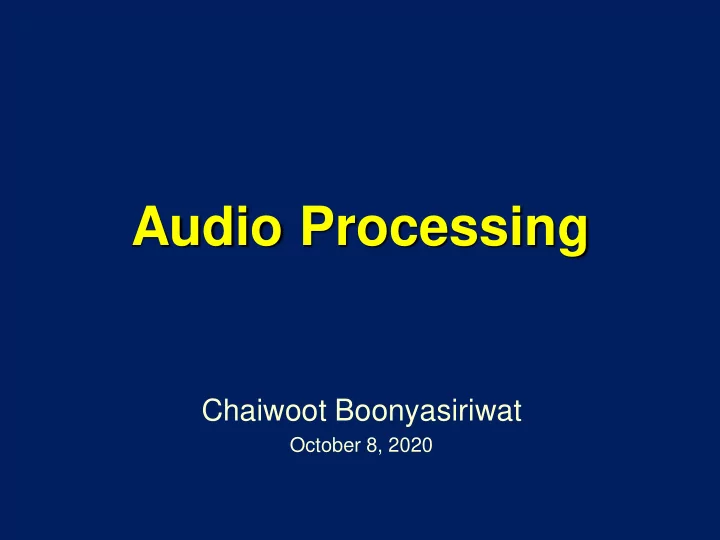

Audio Processing Chaiwoot Boonyasiriwat October 8, 2020
Audio Processing System ▪ An example of an audio processing system is given as ▪ In ADC converters, analog sound signal is first filtered by an anti-aliasing filter to prevent aliasing before it is sampled. 2 Christensen (2019, p.35)
Audio Sampling Frequencies Common audio sampling frequencies and examples of their applications are given below. 3 Christensen (2019, p.36)
Music Theory ▪ A note is a symbol denoting a musical sound. ▪ A note can represent the pitch of a sound in musical notation or a pitch class (e.g., A, B, C, D, E, F, G). ▪ A pitch is a perceptual property of sounds and is closely related to frequency. High pitch → high frequency ▪ Notes are the building blocks of music. A0 = 27.5 Hz A1 = 55.0 Hz A2 = 110 Hz A3 = 220 Hz A4 = 440 Hz 4
Music Theory ▪ Most Western music is based on the twelve-tone equal temperament (TET) which is a tuning system that has 12 notes or semitones (C, C # /D b , D, D # /E b , E, F, F # /G b , G, G # /A b , A, A # /B b , B) within an octave. ▪ An octave is the interval between one musical pitch and another with double its frequency. For example, A 3 and A 4 are one octave apart. ▪ The ratio of the frequency of two consecutive notes, e.g., C 4 and C # 4 , is always equal to . ▪ A 4 (440 Hz) is the reference note. ▪ Any note can be expressed as where k is an integer. 5 Christensen (2019, p.69)
Music Theory ▪ The ratio between two frequencies is called an interval in music and can also be thought of as a difference on a logarithmic scale. ▪ Since human perceives sounds in a logarithmic scale, equal intervals are perceived as a difference in pitch. ▪ An interval can be measured in terms of semitones, octaves, or cents. ▪ Cent is a sub-semitone unit. There are 100 cents per semitone, i.e., 1200 cents per octave. ▪ The interval between two frequencies f 1 and f 2 can be computed in cents as 6 Christensen (2019, p.70)
MIDI Tuning Standard ▪ In MIDI Tuning Standard, a pitch denoted as F 0 is computed by where f 0 is the pitch in Hz. ▪ When f 0 is equal to a semitone, F 0 is an integer. ▪ A 4 (440 Hz) corresponds to MIDI note 69. 7 Christensen (2019, p.70)
Music Theory ▪ “A scale is a set of notes defined by the intervals of the notes in relative to the root note or tonic.” ▪ “For example, the A minor scale, where A is the root note, comprises A, B, C, D, E, F # , and G where the intervals between consecutive notes, expressed in semitones, are 2, 1, 2, 2, 1, 2.” ▪ “A chord is a set of two or more notes played simultaneously.” ▪ For example, A minor chord consists of the notes A, C, and D (root, 3 rd , 5 th notes of the A minor scale). ▪ A major chord consists of the notes A, C # , and D (root, 3 rd , 5 th notes of the A major scale). 8 Christensen (2019, p.71)
Audio Effect: Echo ▪ A single echo can be generated by an inverse comb filter represented by the difference equation where c < 1 determines how loud the echo is relative to the original sound, and d is the delay time in samples. ▪ Multiple echoes can be generated by representing multiple inverse comb filters connected in parallel. ▪ Multiple echoes can also be generated by a comb filter 9 Christensen (2019, p.120)
Audio Effect: Vibrato ▪ Vibrato is a sound effect generated by time-varying delay which is a frequency modulation (FM) ▪ “The delay d ( k ) is typically in the range of 0 – 10 ms while it varies at a frequency of 0.1 – 5 Hz. ▪ An example of a delay function is where D is called the depth measured in samples and f is the frequency (speed) of the time-varying delay. The value of d ( k ) will vary between 0 and D . 10 Christensen (2019, p.120)
Audio Effect: Vibrato 11 Christensen (2019, p.122)
Audio Effect: Tremolo ▪ Tremolo is a amplitude-modulation (AM) sound effect which can be generated by the filter where m k is called the modulating signal and x k is called the carrier. ▪ For the tremolo effect, the modulating signal has the form where f < 20 Hz and 0 < A 1. ▪ “If f is too high, the effect will not be perceived as a time-varying loudness but as adding roughness to the input signal.” 12 Christensen (2019, p.123)
Audio Effect: Tremolo 13 Christensen (2019, p.124)
Audio Effect: Chorus ▪ “The chorus effect imitates the effect of several musical instruments playing the same part while not being completely in sync and playing at the same volume.” ▪ To emulate two instruments playing together, we can use an inverse comb filter ▪ Here, the time-varying delay d ( k ) must be so small that they are not perceived as distinct echoes. ▪ To emulate multiple instruments playing together, we can use multiple comb filters connected in parallel 14 Christensen (2019, p.125)
Audio Effect: Chorus ▪ The delay function can be where F i is the delay offset in samples, D i is the depth in samples, and f i the frequency. ▪ Typical values for these parameters are F corresponding to 10 ms, frequency f of 0.2 Hz, and depth D corresponding to 20 ms. 15 Christensen (2019, p.126)
References ▪ Christensen, M. G., 2019, Introduction to Audio Processing, Springer. ▪ http://www.ee.columbia.edu/~ronw/dsp/ ▪ https://pages.mtu.edu/~suits/notefreqs.html ▪ https://en.wikipedia.org/wiki/Guitar_tunings
Recommend
More recommend